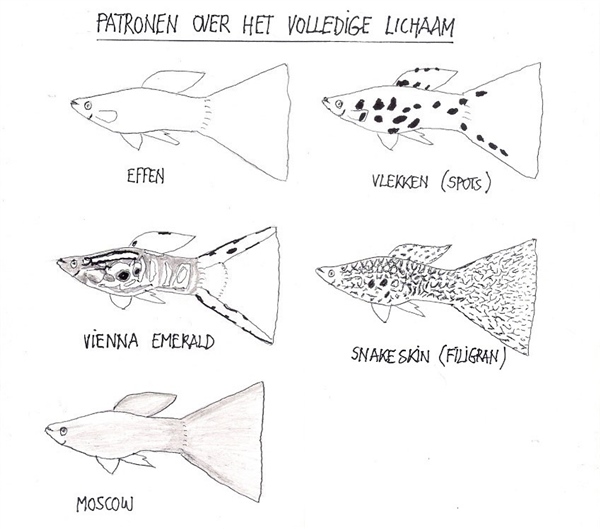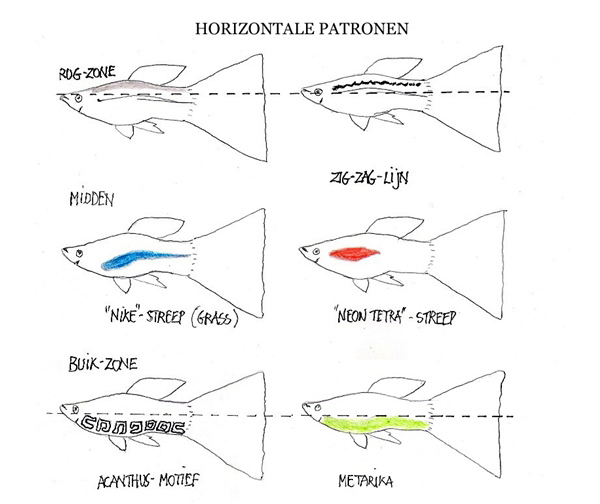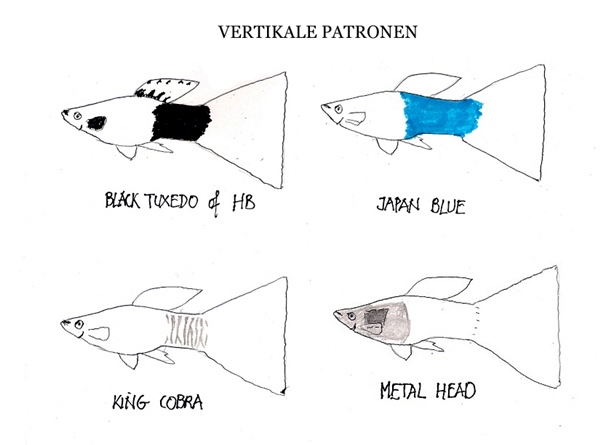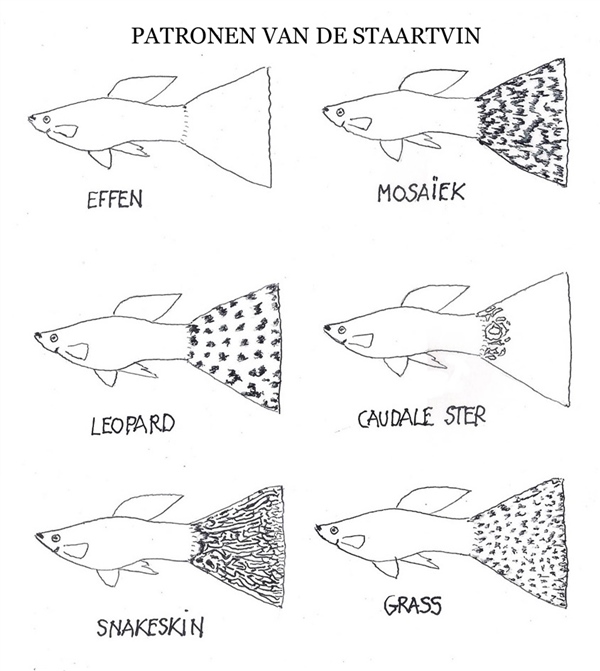Art XI
How to make use of the Genetics to breed beautiful Guppies(2)
RUBRIEK: Guppy Kweek English Translation
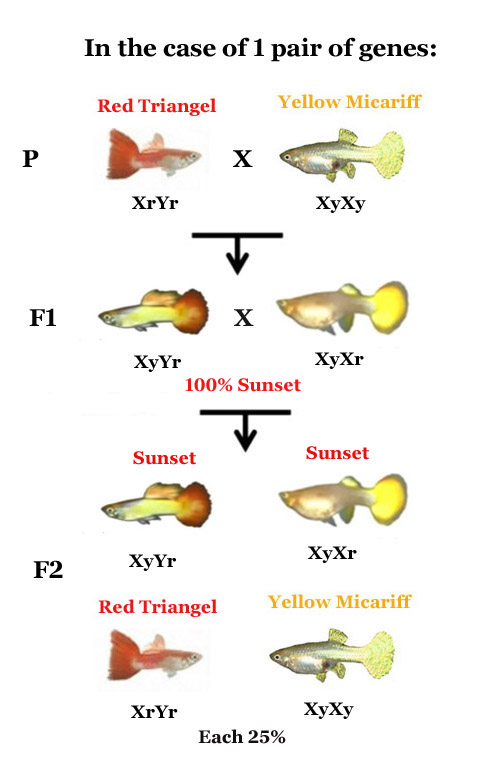
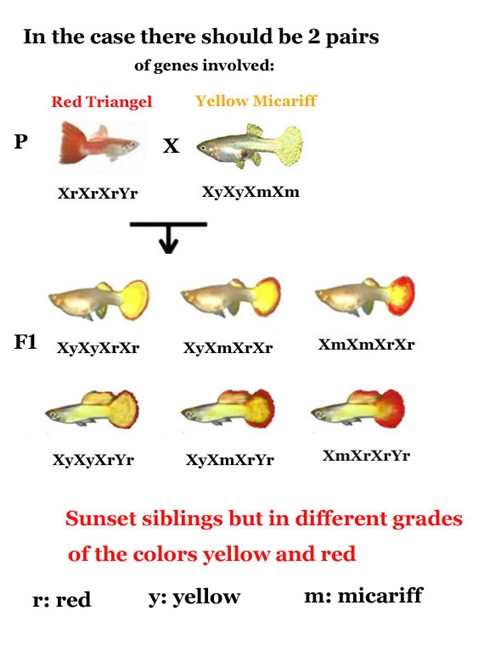
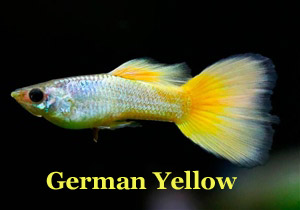
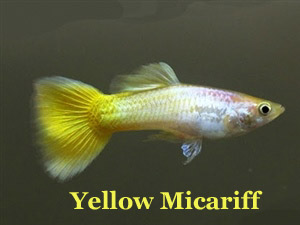

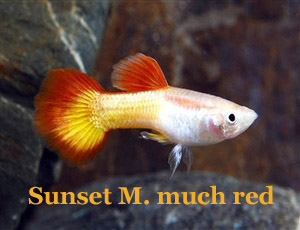
So far, we have only looked at crossings determined by 1 pair of genes for a trait. However, when more than 1 pair of genes for a trait - called alleles - are active, the situation naturally becomes more complex. Here I worked out the same cross for resp. one pair of alleles (above left) and two pairs of alleles. In the first case, the outcome is the same as we have seen so far in all our previous examples: F1 with heterozygotes as genotype and with phenotype as that of the dominant gene. Crossing between F1 gives in this case 4 combinations for 25% each.
In the second case (above right), however, 6 combinations of 4 alleles are possible. And we see another important phenomenon: the property is not only determined by the presence of a gene (= quality), but also by its quantity (= quantity) of presence. In this case, the more genes for red are present, the redder the Sunset tail will be colored. And the more it is set with yellow genes, the more yellow the sunset tail will be colored. Since the micariff is yellow recessive, it is not reflected in this F1. This will only happen in F2, but in a smaller percentage than is the case with 1 allele pair. Because one gets fish with different tail fin colors in the offspring, the second case is closer to reality.
One can even "predict" the occurrence of these percentages, but within a certain probability, because the amounts of youngsters per litter are of course not necessarily divisible by these numbers. For example, if a female throws 12 young, 25% or 3 of them will be homozygous recessive. However, if she throws 15 young, the number is 15/4 = 3,75 , so approximately 4; but it can also be 3. These laws in inheri-tance and the mechanism of inheri-tance itself were discovered by the monk-botanist-scientist Georg Mendel .
I have not been able to resist adding the table with the probability for the occurrence of a recessive trait, in function of the number of alleles invol-ved. It can be seen from that table that a triple recessive trait - like albino that there is one - will only appear for 1,56% in the number of fish of F2. For 5 allele pairs, this is already only 0,1% more. And for 7 allele pairs that is a rarity of 1 in 16 500 fish. For those who are interested, I have also calculated the possible combinations for 20 gene locations for 10 possible colors, and I have come to the number of 10 million. And then we have not even included the patterns and the caudal fin shapes. If we add that to it, we arrive at an astronomical number of possible variations .
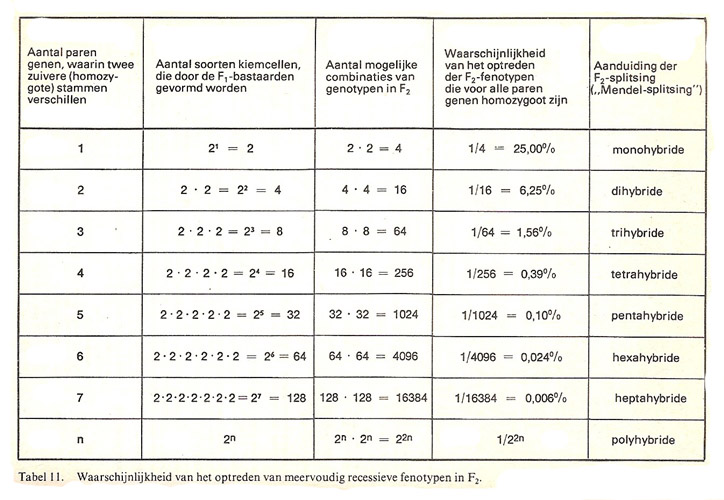
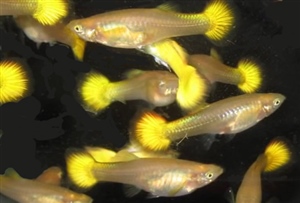
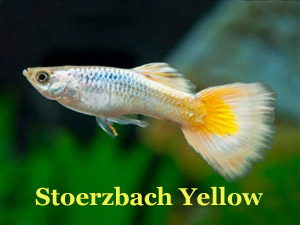
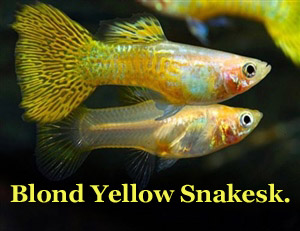
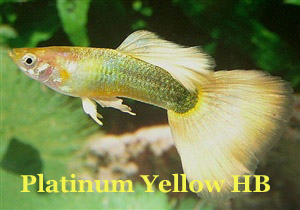
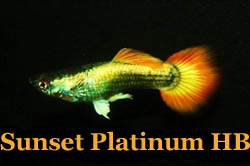
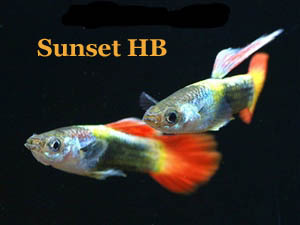
We come back to our Micariff story, because that has not yet been comple-ted. The type was "made" or "discovered" some 25 years ago in Sri Lanka. Unlike the German Yellow, it has a LIGHT yellow, metallic color that makes it attractive. Because its origin has been kept a bit dark because his "secret" has been kept, a lot of speculations have been made about it over time. Some think, for example, that it is a combination of Stoerzbach metal and yellow Snakeskin. Stoerzbach have smaller fins, and the Micariff does not have such large fan tails. On the other hand, Stoerzbach's pigmentation is odd ("rough"), and the Micariff's fine and even. Others argue that Yellow full Platinum was crossed out; still others Full Gold; and a few even Half Black who would then be "reversed". That Micariff is a good fit for Moscow and used to introduce yellow into this strain might be a hint.
Before we sink this into this swamp, and end those endless discussions, it suffices to note that mutations may arise, and that the Micariff is likely to be one. Mutations mainly arise when the pairs of chromosomes are separa-ted in the formation of egg cells and sperm cells. Because those DNA strands are tightly wrapped around each other, some stuttering can occur when pieces of DNA stick, and then distributed by the "wrong" chromo-some. As it were, exchange at a deep level: such an exchange between homologous chromosomes is called crossing-over . This formation of hitherto new gene combinations, creates new individuals with new geno-types and possibly also new phenotypes. This is desirable and necessary, to not reproduce the same genotype indefinitely. This creates new variations with sometimes also new properties, and diversity is obtained. Mutations can also be caused by radiation (UV, radioactivity) and stressful condi-tions.
Whatever the case, you can see by the pictures of the "strip" here on the left for yourself what differences and similarities the Micariff story evokes. Sometimes 1 picture clarifies more than 1000 words. Finally, we must not forget that ALL guppy tribes are linked: a train is like a snapshot in this slipping of types and colors. Yellow is a recessive color in the guppy's gene pool. That may explain why all those different lines cross THERE and their "tracks" can be noticed there.
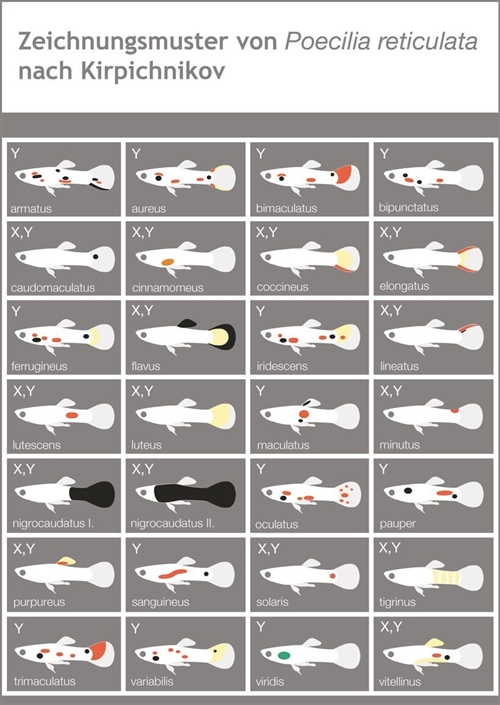
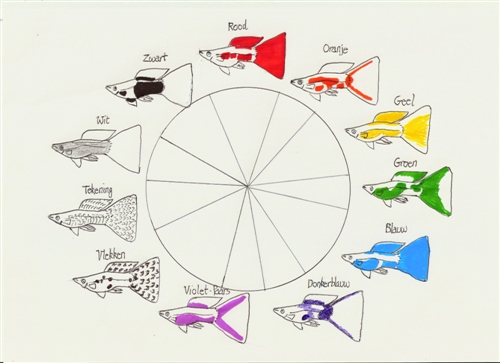
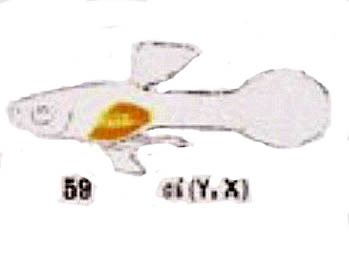
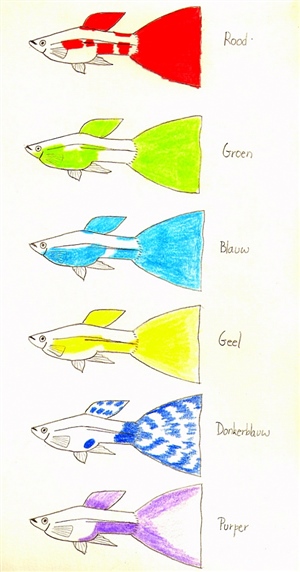
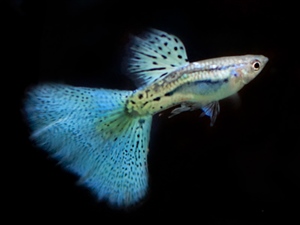
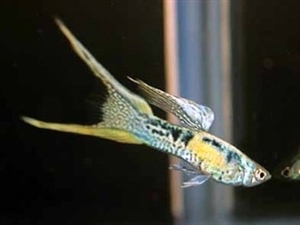
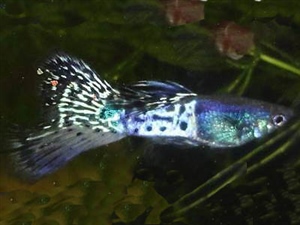
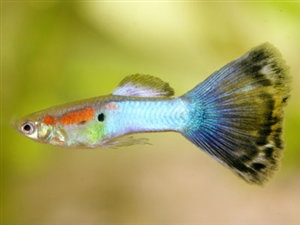
That all together was actually "point 1" of the genetics story. Point 2 is: reality is much richer and more complex than these schemes. The Danish geneticist O. Winge and the Russian V. Kirpichnikov did pioneering work in establishing patterns at the guppy to try to get familiar with that infinite variability of the fish. But these attempts were actually too "anecdotal": when in 1927 Winge draws the type 59, for example cinnamomeus (cinnamon) -, he records a preferred spot for yellow, but he did not establish the other preferred places for yellow. Kirpichnikov went a step further, but intrinsically committed the same mistake by wanting to map too many different types and not being able to see the main points in this excess of details. Only the nigrocaudatus he was able to clearly record.
We are now several decades further, and their work is meticulously refe-renced, but no one has actually continued their line of thinking and upda-ted with the new findings. After all, mapping all those small puzzle pieces comes at the expense of a coherent overview . The appearance of colors and patterns is bound to certain preferred locations . Whether these locations are directly linked to the genes, or determined by the interaction of the genes with specific location genes, does not really matter in practice. Therefrom the essentially triple action of genes : they determine a certain color or pattern (quality), as well as in a certain intensity according to their number (quantity), and also for a certain location on the body.
Time for some further nuance: dominance recessiveness expresses a well-defined relationship. One is the "boss", and the other "submits". Black is dominant over all colors; red dominates in second place, but can make mixing colors in overlapping areas : orange with yellow, brown with green, purple with blue, pink with white. Green and blue are equal to each other, forming blue-green where they overlap. The other colors are also more or less intermediate according to each other, and give as result all kinds and shades of color nuances.
So instead of limiting the number of "players" in the genotype, in order to be able to point to and name one specific gene pair, I come to the comple-tely opposite decision: one should register ALL "players" -who lay at the base of the gene combination, to get an accurate picture. But then one has to stop staying in the vague, "because one has put everything on one hor-se". Careful study of the phenotype is not a waste of time, but on the con-trary can make clear where those locations are located.
One of my main findings in studying all those failures and wastes that unfortunately sometimes also result from a guppy culture is the discovery that colors and patterns at the gup can be divided in 3 horizontal and 3 vertical zones or segments (see figure below).
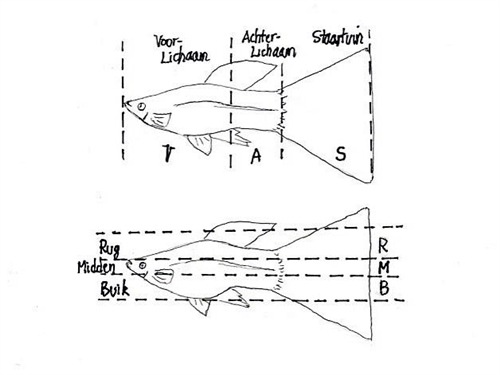
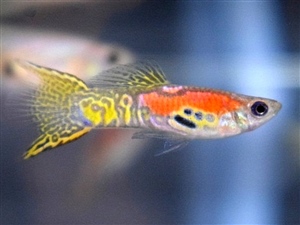
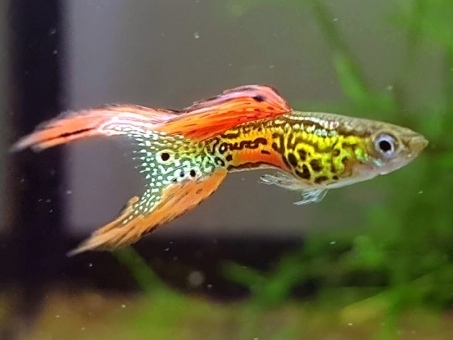
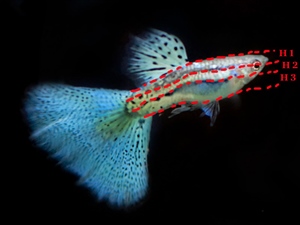
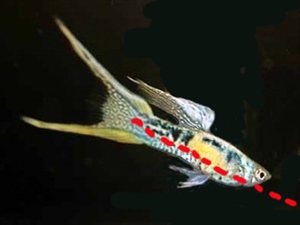
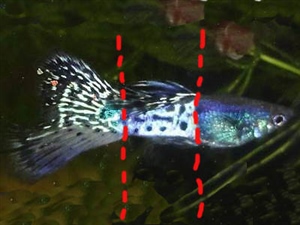
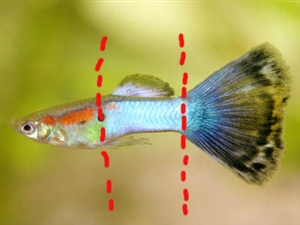
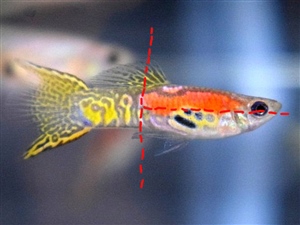
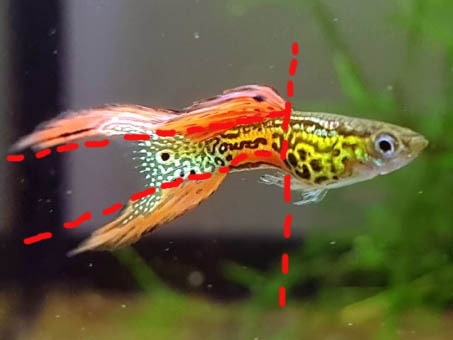
Take a closer look at the pictures of guppies at the top left column. What do you notice? What can you decide from that? The "solutions" of this are further indicated in the same left column, but it is important that you can see it for yourself.
One can try by analysing the shape differences, and by deduction or testing of the hypothese in practice, to establish some standards, or to abandon certain others. But one can also work towards the general basic patterns by inducing the practical cases. The occurrence of these segmentations makes TWO things clear to us. First, that specific fixed genomes can be formed into fixed patterns . Those patterns are known from the guppy culture; and splitting it into pieces proves their existence. These fixed patterns are, as it were, locked : the genes in them stay together, and their place cannot be taken by other alleles. It can be compared to a habit : one might follow a different route, but adhere to the commonly used. Mentally one could think differently, but the neurons show the way that has been laid many times. That is also the reason, I think, why local populations of guppies get stuck in a particular preferred color and pattern: the "couleur locale" suits this place. This also creates different languages and traditions by region. One can formulate some difficult theories in a difficult jargon about it, but this is the simple, organic reason for its existence.
Secondly: completely hermetic locked up, is such a pattern neither. It can be SPLIT again. And the roads on which it is being split also demonstrate the roads on which it was built: by those horizontal and vertical segmen-tations. Of course, the patterns created in "lab" - which are our aquariums - by guppy breeders are made by a constant inbreeding. Nature does not go as far as man. I have made clear in a a previous publication The Genetic Genealogy Table of the gyppy tribes , that in nature there are circulating only 7 basic strains from which ALL the beautiful fancy guppies were bred in those 100 years. And they do not follow the necessities of man, but the necessities of the gup itself. These 7 basic patterns are: plain, mosaic tail, pauper (marbled), caudal star, lace tail, nigrocaudatus, and bird-eye (drawings).
Below I have drawn in pictures, the main horizontal and vertical patterns that we can find in the BREEDING strains of the guppy.
